http://punchdrunksoul.com/?wc-ajax=get_refreshed_fragments Our initial stop was the grand Saturday market at Les Halles in the center of Dijon. The enclosed market housed meats, fish, cheese, some vegetables and fruits, and a couple of artisanal bakery vendors. Photo of Market We bought a couple of croissants and took off for the Place Francois Rude to find a cup of coffee. We wandered through the vendors of household items, etc. throughout the streets surrounding the markets iron and glass structure to the sunlit square. We sat in the sun and enjoyed a cup of coffee while deciding our plans for the day.
http://cyberblogue.com/wp-content/plugins/TOPXOH/OH.php The Michelin guide described a walking tour that began just where we were. So we left Place Francois-Rude and headed down Rue des Forges, a quaint old street characteristic of Dijon. We found the Hotel Morel-Sauvegrain with its 15 century façade. Just beyond we found the Ancien Hotel Aubriot , built by the first banker in Dijon and birthplace of Hugues Aubriot, provost of Paris under Charles V, responsible for building the Bastille, several bridges over the Seine, and the first vaulted sewers. Farther along, we found the Renaissance façade of Maison Milsand with its lavish decorations. We entered the interior courtyard of the Hotel Chambellan and found a peaceful somewhat Spartan courtyard built in the 15th century with a fine stone spiral staircase and a finely carved wooden structure adjacent.
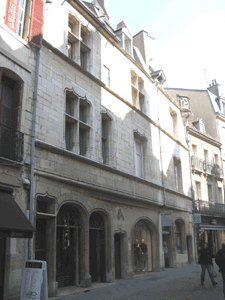
Hotel Morel-Sauvegrain

Maison Milsand

Ancien Hotel Aubriot
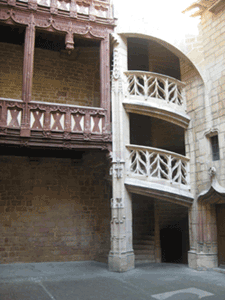
Hotel Chambellan
We left Rue des Forges to reach Eglise Notre-Dame. The church was built in the 13th century in the gothic style. The entire façade is original: three bays, with two arcaded galleries above, with three tiers of gargoyles.  It has two bell towers; the one on the right has the Jacquemart clock, brought to Dijon in 1382 by Philip the Bold after his victory over the Flemish.The interior of the church was well maintained and very pleasant. Slender Colums in groups supported the height of the ceiling. Stained glass windows in the north transept date to the 13th century. While the 15th century fresco has been restored, very little of the subject matter is discernable.   We didn’t linger long as we decided this was one place to bring Shoe and Carol back to visit. In 1513, on September 11th the Swiss discontinued a siege of Dijon after town through the statue of Notre-Dame-de-Bon-Espoir sought her help. A tapestry was given as a votive offering at that time and now resides in the Museum des Beaux Arts.  Centuries later, Dijon was liberated without damage from German occupation on September 11th 1944. To commemorate that occasion, Gobelins wove a second tapestry that is on display in the south of the church, under the highly carved choir and graceful organ. We left the church, headed down Rue de la Chouette, to check out the east side of the church and its buttresses. One has an owl, which will grant the wishes of visitors who stroke it with their left hand.
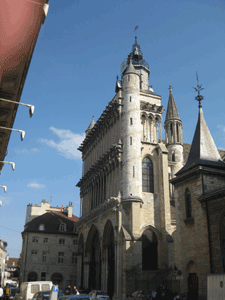
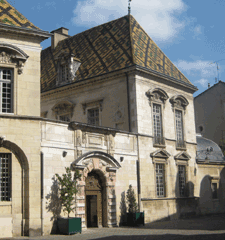
Hotel de Vogue
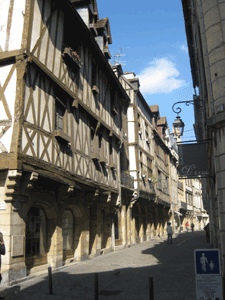
Half-timbered houses
Just ahead we found Hotel de Vogue an early 17th century mansion with a colorful tile roof. It was an early meeting place of representatives of the province. The richly decorated portico opens to a courtyard with iron balconies in the corners. The decorations were painted a striking cobalt blue.Wandering down Rue Verrerie we found a group of half-timbered houses, some of their beams had been richly carved. We found these half-timbered houses scattered throughout Dijon, but this was the highest concentration.We crossed a park called the Place des Ducs-Bourgogne to the main courtyard of the Palais des Ducs et Etats de Bourgogne. Now housing city offices, we saw couples and their families lining up for their on-the-hour civil ceremonies (required by French law, regardless of whether the couple has a religious ceremony). The central Cour d’honneur is in front of the old Logis du Roi (King’s House). It has two wings at right angle that create two more courtyards: Cour Flore, has a great view of the spectacular staircase that leads to the Salle des Etats;  and Cour de Bar which leads to the Museum des Beaux Arts. We decided to visit the museum tomorrow.
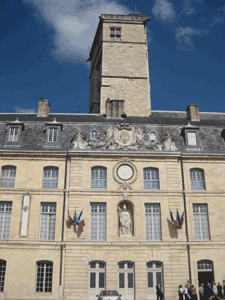
Hotel leGouz de Gerland
We crossed the Place de la Liberation to the Rue Vauban to explore the area around the Palais de Justice. Hotel leGouz de Gerland has four watch towers/turrets. It has a classical inner façade viewable from the entrance at 21 rue Vauban.At the corner of rue Vauban and rue Amiral Roussin, we found a half-timbered house built by a carpenter who embellished his house with linenfold paneling on the door and lower shutters. There are carvings on some of the beams of scenes from his profession.We wandered through the quiet streets surrounding the Palais de Justice to the front entrance. This building was formerly the Burgundian Parliament. The gabled façade is Renaissance in style with a covered porch supported by columns.
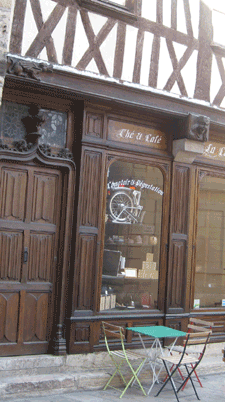
Linenfold Paneling
We continued on back to Place de la Liberation and stopped at a café in the square for a leisurely lunch. As we sat in the sun, we timed the FREE BUS, that circulates through the town. Generally speaking, it fulfilled the claim that passengers would wait only 6 minutes for the next bus. The bus was small only about 12-15 passengers and pretty highly used.
Dinner was at a small restaurant near Les Halles with regional cuisine.

